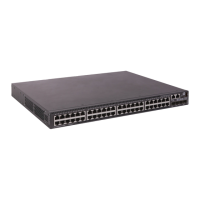49
User role name Permissions
level-n (n = 0 to 15)
• level-0—Has access to diagnostic commands, including ping, quit,
ssh2, super, system-view, telnet, and tracert. Level-0 access rights are
configurable.
• level-1—Has access to the display commands of all features and
resources in the system except display history-command all. The level-1
user role also has all access rights of the level-0 user role. Level-1 access
rights are configurable.
• level-2 to level-8, and level-10 to level-14—Have no access rights by
default. Access rights are configurable.
• level-9—Has access to all features and resources except those in the
following list. If you are logged in with a local user account that has a
level-9 user role, you can change the password in the local user account.
Level-9 access rights are configurable.
{ RBAC non-debugging commands.
{ Local users.
{ File management.
{ Device management.
{ The display history-command all command.
• level-15—Has the same rights as network-admin.
security-audit
Security log manager. The user role has the following access to security log
files:
• Accesses to the commands for displaying and maintaining security log
files (for example, the dir, display security-logfile summary, and more
commands).
• Accesses to the commands for managing security log files and security
log file system (for example, the info-center security-logfile directory,
mkdir, and security-logfile save commands).
For more information about security log management, see Network
Management and Monitoring Configuration Guide. For more information
about file system management, see "Managing the file system."
IMPORTANT:
On
ly the security-audit user role has access to security log files.
Assigning user roles
You assign access rights to users by assigning a minimum of one user role. The users can use the
collection of system items and resources accessible to any user role assigned to them. For example, you
can access any interface to use the qos apply policy command if you are assigned the following user
roles:
• User role A denies access to the qos apply policy command and permits access only to interface
GigabitEthernet 1/0/1.
• User role B permits access to the qos apply policy command and all interfaces.
Depending on the authentication method, user role assignment has the following methods:
• AAA authorization—If scheme authentication is used, the AAA module handles user role
assignment.

